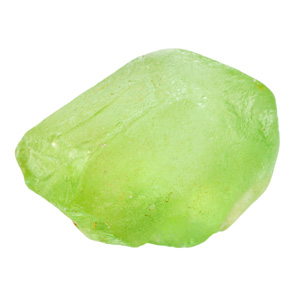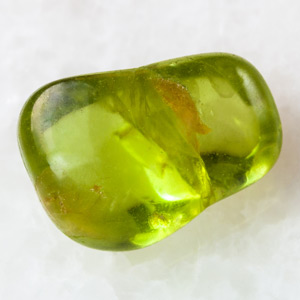olivine
Olivine, a captivating gemstone known for its vibrant green hues, derives its name from its olive-green to yellowish-green coloration. This mineral, composed of iron, magnesium, and silicate, belongs to the nesosilicate group.
Olivine's geological origins are primarily associated with igneous rocks, especially those in the mantle of the Earth. It forms as a result of high-temperature processes and is often found in volcanic basalt rocks and meteorites. Notable sources include regions with volcanic activity, such as Hawaii and the Canary Islands.
Peridot, a gem-quality olivine, has a distinctive green colour and is highly regarded for its use in jewellery. It is one of the few gemstones that come in only one colour—varying shades of green, from yellowish-green to deep, rich green.
Olivine has a unique history, being found in meteorites and some lunar samples, emphasizing its extra-terrestrial presence. Additionally, olivine's connection to volcanic activity and its place in the Earth's mantle make it a fascinating gemstone in the world of geology and mineralogy.
Click on the terms in the table below to discover their meaning
Click on the terms in the table below to discover their meaning
| Name | Olivine |
|---|---|
| Category |
Nesosilicate |
| Chemical Formula |
|
| IMA Symbol | Ol |
| Crystal System | Orthorhombic |
| Crystal Habit | Tabular or prismatic, typically with wedge-shaped terminations; commonly granular, compact, or massive. |
| Twinning | Uncommon as simple twinning or cyclic twinning |
| Cleavage | Good / Distinct |
| Fracture | Conchoidal |
| Tenacity | Brittle |
| Hardness (Moh's Scale) |
6.5 - 7 |
| Specific Gravity | 3.275 - 4.392 |
| Diaphaneity | Transparent to translucent |
| Colour | Green, yellow, brown, white, grey, blue-grey |
| Streak | White |
| Lustre | Vitreous to resinous |
| Optical Class | Biaxial (+) |
| Refractive index | n = 1.650 - 1.703 |
| Birefringence | δ = 0.032 - 0.038 |
| Dispersion | Rd = 0.020 |
| Pleochroism | X = Z = pale yellow; Y = yellow-orange, reddish brown |
| Clarity | Type II |
| Notable Varieties | Peridot, Ludwigite Peridot, Manchurian (Changbai) Peridot |
References
Mineralogical Society of America. (2001). Fayalite. In J. W. Anthony, R. A. Bideaux, K. W. Bladh, & M. C. Nichols (Eds.), Handbook of Mineralogy. Chantilly, VA 20151-1110, USA: Mineralogical Society of America. Retrieved from https://
Mineralogical Society of America. (2001). Forsterite. In J. W. Anthony, R. A. Bideaux, K. W. Bladh, & M. C. Nichols (Eds.), Handbook of Mineralogy. Chantilly, VA 20151-1110, USA: Mineralogical Society of America. Retrieved from https://
Schumann, W. (2013). Gemstones of the World (17th ed.). (D. Shea, & N. Shea, Trans.) New York: Stirling Publishing Company.


